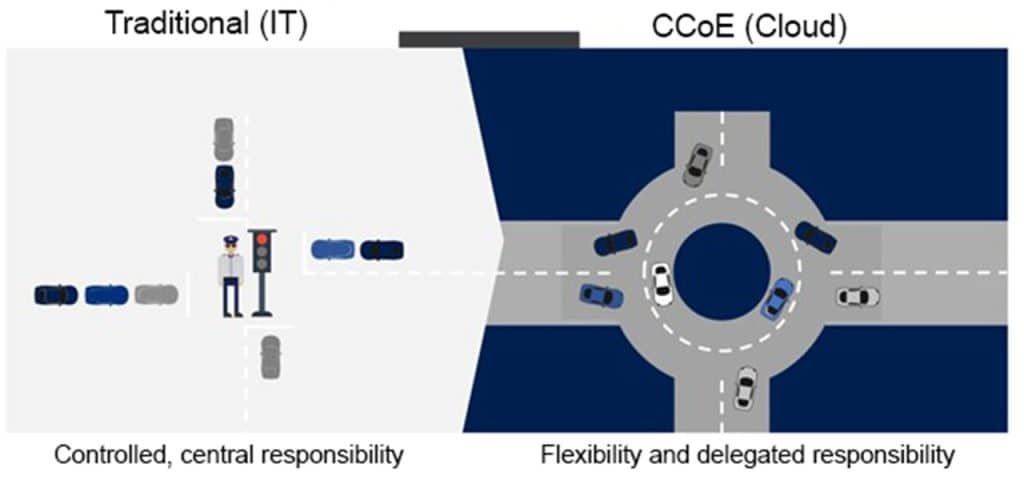
A journey to the clouds never ends
How do you ensure you don't get lost?
Government agencies and financial institutions are increasingly migrating their infrastructure to the public cloud. They are driven by the desire to enrich their services with the speed, flexibility, and scalability that the cloud offers.
The real winners in this so-called transformation are the end users. Their experiences are transformed by improved accessibility, performance, and innovative services. Those winners are us. Every day, we use services that are based on successful cloud transformation. Just think of Netflix, smart home lighting, or the banking app on your smartphone. The extent to which you unconsciously use the cloud every day goes far. Very far. From ensuring proper stocking in the supermarket so you can enjoy a beer on the weekend to your PIN transaction. The cloud improves and transforms our daily lives, our economy, and last but not least, our society.
So, it’s logical that a journey to the cloud opens doors to more efficient operations, service transformation, more innovations, and a stronger market position. But you have to do it right. Because if you do what you did, you’ll get what you got. Copying your current infrastructure to the cloud? Well, to put it mildly, that’s far from enough.

In practice, we often see it go wrong: Organizations often fail to realize that transitioning to the cloud is not just about adopting a new technology, but it also means a significant change in internal processes and organization. Think, for example, of the way of working, the mindset regarding security, and the flood of knowledge and expertise required. Cloud is not ‘just somebody else’s computer,’ as is often joked. Cloud is a principle.
An important lifeline is the so-called ‘Cloud Adoption Framework’ (CAF), which should serve as a guide for every cloud journey. The Microsoft CAF provides a framework that covers all aspects of your cloud journey.
Cloud Strategy
A Cloud Adoption Framework (CAF) always starts with formulating a cloud strategy – the ‘Strategy’ phase. A cloud strategy forms the thread that your entire journey to the cloud is aligned with. You can also see a journey to the cloud as learning to ride a bike. Maybe first with training wheels and definitely with a helmet on, so we are extra safe: First find balance, then hit the road. A clear cloud strategy forms your guardrail, even when you’re already further along the way.
When you’re defining the cloud strategy, you bring together financial goals, strategic objectives, and technical considerations. The business case must be solid. Why are we actually doing this? That way, all stakeholders, not just the technical ones, but also the financial people and management, know: ‘Okay, this is why we’re making this journey, and this is how we’re going to achieve our business objectives with the power of the cloud!’
In the second phase – the ‘Ready’ phase – we write, among other things, the design for the cloud landing zone and make it a reality. The cloud landing zone is a very important foundation where you can land all your applications. Additionally, we involve stakeholders, ensure governance, structure work processes, and ensure alignment with the strategy. We do this by forming a ‘Cloud Center of Excellence.’ A Cloud Center of Excellence (CCoE) is the epicenter where the paths of adoption, strategy, governance, and automation converge.
In the absence of a CCoE, traditional IT tends to maintain control and centralized responsibility, similar to the function of traffic lights at an intersection. However, an effective CCoE transforms this intersection into a roundabout, which not only promotes flow but also enables the organization to realize and leverage the full potential of cloud transformation.

After the ‘Ready’ phase comes the ‘Adopt’ phase, where we start, among other things, by creating the migration strategy. In the migration strategy, we collectively decide the migration methodology for each application. The choices we have in this regard are what we call the 7 R’s: (Discover the cloud migration scenarios). Once the migration strategy is clear, we migrate the application landscape step by step to the new environment. Management, Governance, and Security are addressed within the new environment during this phase.
After successful migration, we enter a cycle of ‘Continuous Improvement.’ Your environment is never entirely ‘Cloud-Native’ after the initial migration, or optimized for the cloud. To extract maximum value from the cloud, you must continue to modernize and innovate. Cloud transformation never ends because there are always new developments that offer opportunities for your organization.
For a successful transformation, it’s crucial to fully leverage everything the cloud has to offer. The cloud changes rapidly – just look at the rise of artificial intelligence (AI). Turning on CoPilot for M365 isn’t difficult, but it does mean you need to prepare the people within your organization as well. Implementing AI effectively in your organization also brings its own set of ethical questions and challenges. Navigating through these challenges typically falls into such a cycle of continuous improvement.
Obstacles & Pitfalls
So where does it often go wrong, and what elements cause organizations to sometimes get lost in their cloud journey? Here are some examples of the most common obstacles and pitfalls we see organizations struggling with. We help these organizations get back on the right track with our expertise, but it’s valuable to look at this list of the most common pitfalls before or during your cloud journey:
1. Underestimating Complexity
At a low level of cloud maturity, the knowledge required to use such a cloud environment properly is often underestimated. The same goes for the increase in cognitive load on the involved IT staff. Understanding that the transition to the cloud is not a simple undertaking, will motivate to work actively on transforming your digital environment into a cloud-native landscape.
In traditional IT, control and maintaining the ‘status quo’ are paramount (an intersection with traffic lights). With cloud, flexibility increases significantly, and there is delegated responsibility (a roundabout). This means that sometimes 8 or 9 parties within the same cloud environment deliver their services, and internal departments outside of IT also deploy applications. That’s a significant change.
Creating a Cloud Center of Excellence enables you to manage that change organization-wide, fully exploit the potential of the cloud, and benefit optimally from all the advantages the cloud offers.
2. Deadlocks
Many organizations don’t know where to start. Or they have made a start, but get stuck. These organizations may have a cloud strategy, but they don’t know how to get from A to B. They often lack a Cloud Center of Excellence and a strategic partner who proactively guides and supports them on their cloud journey.
To reduce the risk of this pitfall, engage a strategic partner, review your cloud strategy, and establish a Cloud Center of Excellence.
3. The ‘First Cloudbill Shock’
Your organization receives the first bill from the cloud provider after migration and is confronted with unexpectedly high costs. How is that possible!? The business case was much more positive! Higher costs than expected can have various causes, such as a lack of understanding of the price structures of cloud services, unforeseen expenses due to overprovisioning of resources, but by far the most common cause: Simply not or not fully utilizing the opportunities for cloud optimization.
Cloud is cheaper in most cases, but only if you do it right. You do this by prioritizing cloud optimization in your plan. If you address that properly, you can avoid these unpleasant surprises. For more information, read the cloud optimization whitepaper.

4. Legacy applications
Government and financial institutions often struggle to make the transition from IaaS to PaaS or from PaaS to SaaS because their application landscape is outdated. In that case, you can still consume these applications via IaaS in the public cloud. But sometimes that’s not an option either. In municipalities, for example, you can think of the server for Travel Document Application and Archive Station (RAAS). That needs to be in a physical, traceable location.
In that case, the issue can be solved by creating a hybrid cloud model where that part of the application landscape is housed in a private cloud. At Solvinity, this is easy because all services fall under one roof, both private and public cloud.
5. The ‘Silo’ approach
Organizations embarking on a cloud journey often unconsciously adopt the ‘Silo’ approach. This means that they don’t integrate their cloud initiative well with existing processes and IT systems. The result is suboptimal efficiency and collaboration. Not the entire organization is involved, which, as a side effect of the ‘Silo’ approach, also promotes resistance to change. Consequently, employees understandably cling to what they know: existing processes and technologies.
You can address the ‘Silo’ approach with a strategic approach to your cloud journey. This can include establishing a Cloud Center of Excellence that advocates for cloud transformation throughout the organization and using a CAF as a guide.
6. Security
Ignoring the security aspects of the cloud can lead to data breaches and compliance violations. Security in the cloud is fundamentally different from traditional IT environments and requires a different approach.
By making the right choices beforehand, you can save your organization a lot of unnecessary costs and risks. The CAF has a separate guideline for this, ‘Secure.’ This guideline helps organizations make the right decisions and address security issues. Again, a strategic partner like Solvinity can play a crucial role.
7. Compliance
And then there are compliance issues. For example, government agencies must comply with the Baseline Information Security Government (BIO). And financial organizations must follow the guidelines of the DNB or the AFM.
Choosing a ‘safe option’ like private cloud seems simple in that respect. Public cloud environments were generally seen as less secure than private cloud, while there is much more visibility in public cloud environments. We even see that organizations struggling with their compliance and security are encouraged by the DNB or the government to move to the public cloud precisely because of the extra visibility and control over compliance. The security status of your environment is simply available and visible in the public cloud.
For customers with a hybrid cloud, our challenge is to provide an overview of those two worlds (Private and Public) that make up the cloud environment. Solvinity is working behind the scenes to provide one central dashboard, combining the two into a clear overview.
Shaping the future together
The journey to the cloud is never a lonely endeavor. It’s a path we walk together with our customers, carefully considering every step. The importance of listening, adapting and never underestimating the value of thorough preparation are our success pillars for every cloud transformation. Technology serves as a catalyst for change, not only within companies but also within society.
Every customer journey is unique but has one common theme: the quest for growth, efficiency, and innovation. Solvinity aims not only for very high-quality services but also for a role as a strategic partner. The main goal? Secure Managed Cloud for every customer. This is more than just technology. It’s about shaping the future together.
Public Cloud Security
Do you want to read more about the main points of attention and pitfalls for a securely configured cloud environment?
Other articles
More
Take Control of Your Security Strategy with the NIST Framework
Discover how the NIST Framework helps you structure your security approach and keep risks under control...
READ MOREWhat makes a Secure Managed Cloud truly ‘secure’?
What makes a Secure Managed Cloud truly ‘secure’? In an era where cyber threats are constantly...
READ MOREThe complexity of IT Regulations for municipalities
In addition to the daily challenge of managing a secure and efficient IT environment, municipalities face...
READ MORE
